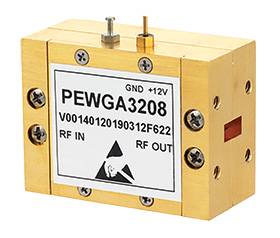

Waveguide amplifiers, or full-band/multi-band waveguide amplifiers, are amplifiers housed in assemblies that have either waveguide or coaxial interconnect. Though waveguide interconnect is more common for waveguide amplifiers, some waveguide amplifiers have coaxial interconnect instead, but still perform as specified over a given waveguide frequency band.
The main feature of waveguide amplifiers is that they are designed to deliver specific performance over an entire waveguide band, or several depending on the device.
There are a variety of types of waveguide amplifiers, with the most common being waveguide power amplifiers and waveguide low-noise amplifiers. Having a waveguide interface on a waveguide amplifier allows for higher power handling, lower insertion loss and standard waveguide fixturing that is both mechanical and environmentally robust.
The benefit of a waveguide amplifier is that a single device can be used to amplify frequencies for an entire waveguide band, as opposed to having amplifiers for a given set of frequency bands from a telecommunications or radar protocol. Hence, waveguide amplifiers are commonly found in test equipment and sensing equipment where measurements may be made throughout a given waveguide band.
As the size of a waveguide interface is directly related to the waveguide frequency band, it is more common to see waveguide amplifiers for microwave and millimetre-wave frequencies, such as K-band and higher. Waveguide amplifiers are commonly used for satellite ground equipment as low-noise amplifiers, as well as high-power transmitters. These amplifiers are also commonly used in test equipment, radar, military radio systems and a wide range of other microwave and millimetre-wave applications. Mainly, the high gain, low insertion loss and overall good electrical and mechanical performance of waveguide amplifier designs make them attractive for many performance applications.
Other important specifications of waveguide amplifiers are gain flatness across a waveguide band, noise figure, VSWR (voltage standing wave ratio), spurious/harmonics, linearity (OIP3 and P1dB), and reverse isolation. Gain variation over operating temperature range and operating temperature range are also important features for some critical applications with harsh environment requirements.
| Tel: | +27 21 555 8400 |
| Email: | [email protected] |
| www: | www.rfdesign.co.za |
| Articles: | More information and articles about RF Design |

© Technews Publishing (Pty) Ltd | All Rights Reserved